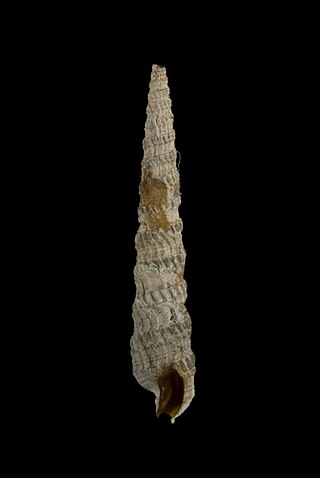
Busycon is a genus of very large edible sea snails in the subfamily Busyconinae. These snails are commonly known in the United States as whelks or Busycon whelks. Less commonly they are loosely, and somewhat misleadingly, called "conchs".

The Terebridae, commonly referred to as auger shells or auger snails, is a family of predatory marine gastropods in the superfamily Conoidea. They have extremely high-spired shells with numerous whorls; their common name refers to the resemblance of their shells to rock-drill bits. More than 400 species are recently known worldwide.

The gastropod shell is part of the body of a gastropod or snail, a kind of mollusc. The shell is an exoskeleton, which protects from predators, mechanical damage, and dehydration, but also serves for muscle attachment and calcium storage. Some gastropods appear shell-less (slugs) but may have a remnant within the mantle, or in some cases the shell is reduced such that the body cannot be retracted within it (semi-slug). Some snails also possess an operculum that seals the opening of the shell, known as the aperture, which provides further protection. The study of mollusc shells is known as conchology. The biological study of gastropods, and other molluscs in general, is malacology. Shell morphology terms vary by species group.

Oxymeris crenulata, common name crenulate auger, is a species of sea snail, a marine gastropod mollusc in the family Terebridae, the auger snails.

Terebra anilis is a species of sea snail, a marine gastropod mollusc in the family Terebridae, the auger snails.
Myurella russoi is a species of sea snail, a marine gastropod mollusk in the family Terebridae, the auger snails.

Myurellopsis columellaris is a species of sea snail, a marine gastropod mollusc in the family Terebridae, the auger snails.
Myurellopsis undulata, common name the undulate auger, is a species of sea snail, a marine gastropod mollusc in the family Terebridae, the auger snails.

Terebra amanda, common name Amanda's auger, is a species of sea snail, a marine gastropod mollusc in the family Terebridae, the auger snails.

Neoterebra armillata is a species of sea snail, a marine gastropod mollusk in the family Terebridae, the auger snails.
Neoterebra biminiensis is a species of sea snail, a marine gastropod mollusk in the family Terebridae, the auger snails.

Hastula cinerea, the grey Atlantic auger, is a species of sea snail, a marine gastropod mollusc in the family Terebridae, the auger snails.

Neoterebra dislocata, common name the eastern auger, is a species of sea snail, a marine gastropod mollusk in the family Terebridae, the auger snails.

Terebra guttata, common name the eyed auger, is a species of sea snail, a marine gastropod mollusk in the family Terebridae, the auger snails.

Terebra laevigata is a species of sea snail, a marine gastropod mollusc in the family Terebridae, the auger snails.
Terebra lindae is a species of sea snail, a marine gastropod mollusc in the family Terebridae, the auger snails.
Neoterebra pacei is a species of sea snail, a marine gastropod mollusk in the family Terebridae, the auger snails.

Neoterebra protexta, common name the fine-ribbed auger, is a species of sea snail, a marine gastropod mollusc in the family Terebridae, the auger snails.

Partecosta veliae is a species of sea snail, a marine gastropod mollusk in the family Terebridae, the auger snails.

Terebra subulata is a species of sea snail, a marine gastropod mollusk in the family Terebridae, the auger snails.















